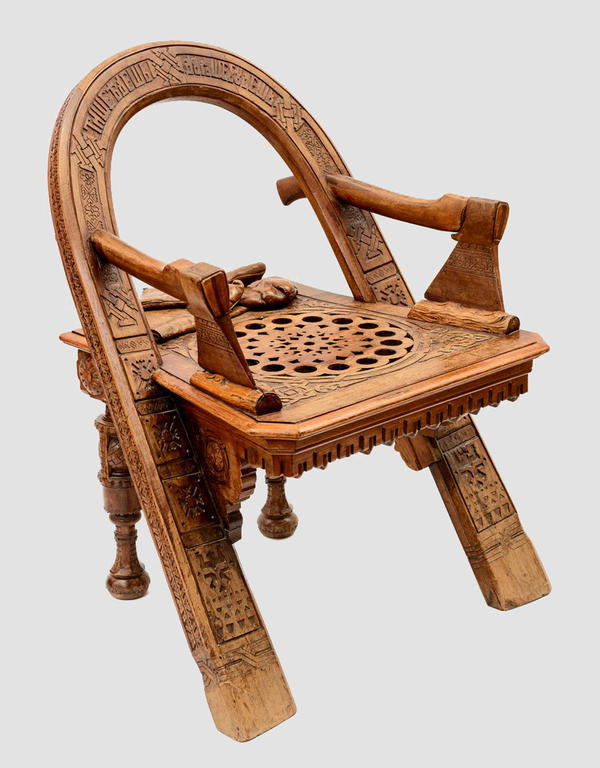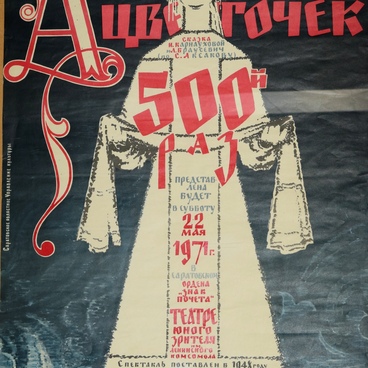This museum’s collection includes the chair entitled ‘Bow, Axe and Gloves’, which is brimming with traditional Russian elements. Its structural components all represent different attributes of peasant life. The back of the chair is made to look like a shaft bow (an element of a horse harness), which seamlessly blends into the chair’s front legs. The seat itself is tapered towards the back, with the armrests designed to look like axes slicing through logs. The chair’s back legs are chiseled and are adorned with carved decorative elements. Both ends of the chair legs are disc-shaped. There is a sphere resting on top of the cylindrical leg. Every part of the chair is covered with carving. A Russian proverb is covered in Church Slavonic along the bow: ‘Ride slower — you will get further.’ The seat itself is decorated with a carved pattern formed of geometric shapes, which resembles a large circle. The armrest axes are decorated by a variety of diamonds and triangles, bordered with straight lines. Three-dimensional wooden gloves rest t the back of the chair, with the author’s name carved into one of them: ‘Shutov’.
The chair was constructed by a master wood carver from St Petersburg, Vasily Shutov. It was first exhibited at the All-Russian Manufacturing Exhibition in St Petersburg, 1870, under the provisional name ‘Bow, Axe and Gloves’. It was hugely successful, and Vasily Shutov received around fifty orders for copies of the chair. The Department of Trade and Manufacturing issued the carver a patent, which gave him the legal right to produce these chairs for ten years. The chair’s popularity was so great that his copies were found in aristocratic mansions, in the apartments of the democratic intelligentsia. One owner of particular note was Antona Chekhova. The original chair sat in Alexander III’s chambers.
After the ten-year patent ran out, many copies and variations of the chair began to appear. Other craftsmen started to produce them, changing the shape of the seat and the proverb on the bow. They also added other attributes of Russian peasant life onto the design, including whips, bridles, bast sandals and balalaikas. Some versions produced by other carvers bear the craftsman’s name on the bow, rather than the proverb. Over twenty of Vasily Shutov’s original chairs have been preserved. As one of the most distinct pieces of furniture made in the ‘Russian style’, they have rightfully put them selves into the history books of world design. The chair became part of the museum’s collection in 1965.
The chair was constructed by a master wood carver from St Petersburg, Vasily Shutov. It was first exhibited at the All-Russian Manufacturing Exhibition in St Petersburg, 1870, under the provisional name ‘Bow, Axe and Gloves’. It was hugely successful, and Vasily Shutov received around fifty orders for copies of the chair. The Department of Trade and Manufacturing issued the carver a patent, which gave him the legal right to produce these chairs for ten years. The chair’s popularity was so great that his copies were found in aristocratic mansions, in the apartments of the democratic intelligentsia. One owner of particular note was Antona Chekhova. The original chair sat in Alexander III’s chambers.
After the ten-year patent ran out, many copies and variations of the chair began to appear. Other craftsmen started to produce them, changing the shape of the seat and the proverb on the bow. They also added other attributes of Russian peasant life onto the design, including whips, bridles, bast sandals and balalaikas. Some versions produced by other carvers bear the craftsman’s name on the bow, rather than the proverb. Over twenty of Vasily Shutov’s original chairs have been preserved. As one of the most distinct pieces of furniture made in the ‘Russian style’, they have rightfully put them selves into the history books of world design. The chair became part of the museum’s collection in 1965.





